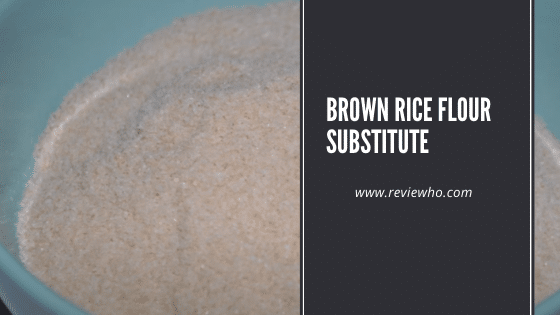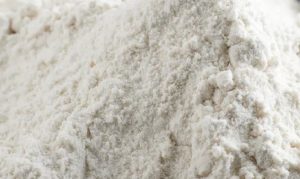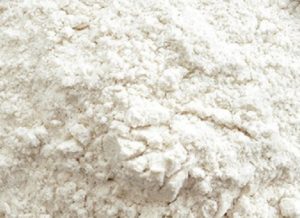Brown rice flour has several purposes in recipes. It is not only multi-purpose but also extremely healthy. It is useful in frying, sauce thickening, as well as baking. Nevertheless, you will find yourself in some situations that will require that you use a brown rice flour substitute. Lucky for us, there are several substitutes for rice flour that are also gluten-free. For instance, you can use sorghum flour in baking recipes.
In this post, we have compiled detailed information including the best alternatives for rice flour, as well as the best way to make it at home.
What Is Brown Rice Flour and How Do You Use It?
Brown rice flour is a very popular ingredient that works as an alternative to wheat flour. It is also gluten-free, making it a very healthy ingredient. It is ground from brown rice grains. Another reason why it is preferred to wheat flour is its nutritional value, which is higher. It is an ingredient that is rich in Vitamin B, fiber, iron, as well as lipids produced by brown rice bran. These lipids have several health advantages, which include decreasing the levels of cholesterol in the body.
Unlike most of the other starches and flour alternatives, brown rice flour has a slightly nutty flavor.
When you mill brown rice, the flour will have a certain creamy white color. You can easily differentiate it from the flour produced by regular rice because regular rice flour has a paperwhite color.
In regards to the uses, the brown rice flour works perfectly for frying, and baking, as well as sauce and gravy thickening. You can also use flour from brown rice as a substitute for other types of flour such as Occident Flour, and the opposite is still possible. It is also possible to mix a certain brown rice flour amount with the other varieties to achieve the consistency you require.
Can You Interchange Brown Rice Flour with White Rice Flour?
It is possible to assume that you can use brown rice flour and rice flour interchangeably. However, even though it is possible to use white flour as a substitute for brown rice flour, it really depends on the recipe you are working on.
The first reason for that is that there is a difference in taste. White rice’s flavor is quite mild, while brown flour’s flavor is nutty.
The second reason is that there is a difference in texture. Brown rice flour is not as light as white rice flour.
For that reason, if you would want to substitute brown rice flour with white rice flour, you would require to use more white flour since it is lighter.
Best Brown Rice Flour Substitute for Baking
If you prefer to use brown rice flour because of its gluten-free features, you should use a substitute that has the same property. Such substitutes include amaranth flour, almond flour, coconut flour, oat flour, and many more. You should swap any of these with brown rice flour at a ratio of 1:1.
Sorghum flour is the best rice flour replacement for baking. Mainly because it is gluten-free, and you should use as much sorghum flour as brown flour in your recipe. It is not only a great replacement for brown flour but also regular wheat flour.
It also happens to have a similar taste to wheat flour. Therefore, if you have wanted to work on a wheat flour recipe and enjoy a gluten-free meal, this is the best replacement.
You will enjoy improved texture because Sorghum flour has an adequate amount of fiber and protein, giving your baked meal adequate stability to maintain the structure. You will also enjoy adequate nutrients. Sorghum flour has adequate antioxidants and minerals such as calcium, zinc, iron, magnesium, as well as potassium, and vitamin B3.
You can also find this alternative very easily in most stores around you.
Best Brown Rice Flour Substitute for Frying
When it comes to frying, a few rice flour substitutes come to mind. The main idea is that the substitutes should be just as light as the coating for brown rice flour. When you deep fry a certain food that is coated with rice flour, the rice flour will not take in a lot of oil. The result is fewer calories in the final meal.
Therefore, when you are choosing a rice flour substitution, you should think about two main factors. The first consideration is that the replacement should be free gluten-free. You can use any all-purpose flour if you are not worried about gluten. However, you should know that using all-purpose flour would make the coating heavier than brown rice flour would.
The second consideration is that the flavor of the substitute should be neutral. It is hard to find flour that has the same flavor as brown rice flour, which possesses a nutty flavor.
The perfect substitutes for brown rice flour when it comes to frying are corn starch and potato starch.
Even though these two alternatives cannot compare to brown rice flour in regards to nutrition, they work perfectly in providing a crispy coating.
They are also similar to brown rice flour in that they do not take in excess levels of oil. Besides, they are gluten-free, which means that they are the best replacements for brown rice flour.
Read: Best Large Flour Storage Containers
Best Brown Rice Flour Substitutes for Sauce Thickening
You can choose to use all-purpose flour for thickening gravies or sauce if you do not have an issue with including gluten in your meal.
When choosing a replacement for sauce thickening, there are not as many alternatives as there are for baking.
You should know that you can choose to use the white rice flour alternatives for recipes that require you to thicken gravy or sauce using some flour. In fact, there are cases where white rice flour works better than the brown rice flour alternative.
The brown rice flour alternative is not as smooth as white rice, which means that there are possibilities of it affecting the smooth texture that the sauce possesses, especially if you add it in large quantities. The white flour alternative is smoother and gentler.
However, the perfect substitute when it comes to thickening sauce and gravy is corn starch.
It is gluten-free and I will produce exactly the same result as brown rice flour when you add it to a sauce or gravy.
You should note that the method you will use when thickening sauce or gravy with corn starch is quite different from the method using brown rice flour.
With brown rice flour, you can simply sprinkle a bit into the sauce or gravy and mix easily. However, if you prefer to use corn starch, you would require to prepare a mixture of corn starch with some water, then pour the mixture into the sauce or the gravy.
You should also know that corn starch does not have the same immediate effects that brown rice flour has. It is advisable to place the sauce on low heat and wait until the starchy flavor is completely finished.
Preparing Your Brown Rice At Home
Brown rice flour can be made from home easily. The only ingredient you require to make brown rice flour is brown rice. You also require a blender with high power or a food processor. You should put the brown rice flour inside the blender and use the highest power setting. Make sure that the rice turns to a consistent flour before you stop the blender. It is that easy!
For everyone who prefers gluten-free flour, it is highly advisable to create a large amount of brown rice flour and store it.
For everyone who does not want to use a replacement in the recipe, learning how to make it is important.
FAQs
-
Can I substitute coconut flour for brown rice flour?
yes! You can absolutely substitute coconut flour for brown rice flour in most recipes. The reason why you can substitute coconut flour for brown rice flour is that they have similar properties.
Both coconut flour and brown rice flour are gluten-free, so they’ll work well in recipes that are meant to be gluten-free. Additionally, both coconut flour and brown rice flour are high in fiber, so they’ll help to keep your baked goods moist and delicious.
The only thing to keep in mind when substituting coconut flour for brown rice flour is that the proportion of flour to liquid will be different. Coconut flour is much more absorbent than brown rice flour, so you’ll need to use less coconut flour than you would brown rice flour, or consider adding an extra egg or ¼ cup of any preferred liquid.
Keep in mind that the texture of your baked goods may be slightly different when you use coconut flour instead of brown rice flour. Coconut flour tends to produce baked goods that are slightly more dense than those made with brown rice flour. However, this difference is usually not significant enough to affect the taste or quality of your baked goods.
So, if you’re looking for gluten-free flour that will still produce delicious baked goods, then substituting coconut flour for brown rice flour is a great option!
-
What does brown rice flour taste like?
Brown rice flour is a staple in many gluten-free and grain-free recipes, but what does it actually taste like? For starters, brown rice flour has a nutty, earthy taste.
This is because brown rice still has the bran and germ intact, which gives it a higher fiber and nutrient content than white rice flour.
Brown rice flour also has a slightly sweeter taste than white rice flour, due to the higher sugar content in brown rice. So, if you’re looking for a gluten-free flour option that has a similar taste and texture to whole wheat flour, brown rice flour is a great choice. And, because it’s higher in fiber and nutrients, it’s a healthier option too!
Conclusion
Learning how to make gluten-free baked meals is a trial and error process. However, the process has been perfected over the years. It is important to use efficient tips when cooking.
For instance, if you are baking with flour, blending two different types of flour will improve your results. However, it is up to you to find a mixture that works best for you. You should also check to see different recipes so that you can learn how to improve the taste of whatever you intend to prepare.
Also Read:
Feel free to share your observations with me in the comments section!
Also, if you find the information in this post to be useful, be sure to share this post with your friends on Facebook, Twitter, and Pinterest!






